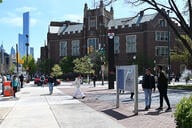You have /5 articles left.
Sign up for a free account or log in.
More than half of low-income students at comprehensive public universities reach the top half of the nation's income earners by their 30s, according to a new analysis from the American Enterprise Institute.
The paper analyzed social mobility data for students who attend the more than 400 comprehensive universities in the U.S., a category of institution that fits between public flagship or research universities and community colleges. Roughly 70 percent of undergraduates who attend a four-year institution are enrolled in this sector, as are more than 40 percent of all undergraduates.
Jorge Klor de Alva, author of the analysis and president of Nexus Research and Policy Center, a nonprofit research group, used data from the Equality of Opportunity Project to write the paper. For his adjusted mobility rate, Klor de Alva calculated the percentage of students from the bottom two income quintiles who rose to the top two quintiles. In addition to the more than half of students who ended up in the top half of income by their early 30s, 80 percent moved up the earnings ladder by at least one quintile.
The report found wide variability in the rate of mobility across institutions, with college completion rates and field of study being the most influential factors.




